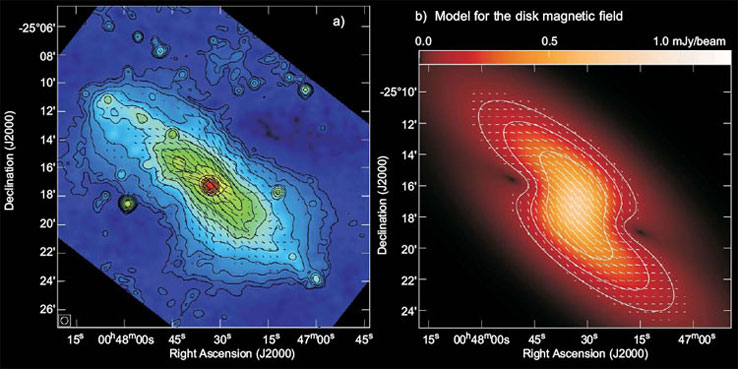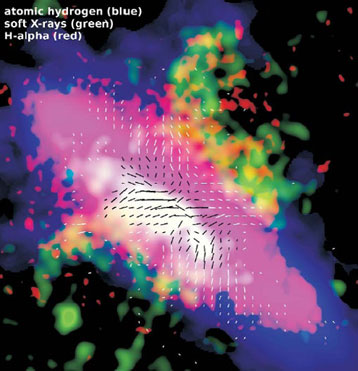NRAO eNews
October 2008 • Vol. 1, Iss. 5
- The Expansion of Supernova Remnant G21.5–0.9: Is PSR J1833–1034 the Youngest Pulsar?
- Discovery of a Small Group Driving the Evolution of an Edge-On Spiral Galaxy
- Cosmic Rays and the Magnetic Field in the Nearby Starburst Galaxy NGC 253
- Neutral Hydrogen Clouds in the M81/M82 Group
- ALMA Project Progress
- North American ALMA Science Center
- The ALMA Spectral Line Catalog
- The Birth and Feedback of Massive Stars, Within and Beyond the Galaxy: The NAASC Science Workshop for 2008
- Current Status
- VLA Configuration Schedule, Proposals, and Scheduling
- VLBA and HSA Proposals and Scheduling
- Global cm VLBI Proposals
- VLA and EVLA Spectral Line Observations Below 1200 MHz
- Status of Observing with the Transition Array
- VLBA Sensitivity Upgrade Project
- First 3mm Science Observations with the GBT and MUSTANG Call for Proposals
- The GBT Dynamic Scheduling System Update
- Progress on the Ka-Band Focal Plane Array for the GBT
- Opportunities for University-Led Technical Development Projects in Green Bank
- New NRAO Website Debuts
- The NRAO at the American Astronomical Society and American Association for the Advancement of Science Meetings
- Call for GBT Shared-Risk MUSTANG Proposals
- Large Proposals to Use NRAO Telescopes
- Chris Carilli Appointed Observatory Chief Scientist
- Eleventh Synthesis Imaging Workshop
- 2008 Grote Reber Medal Awarded to Sandy Weinreb
- NRAO Participates in the BEYA Conference
- NRAO Business Managers Meet in Chile
- NRAO Library News
- Past Issues
- Contact the Editor
- Subscribe
- More Information
NRAO Newsletter • April 2008 • Issue 115
Cosmic Rays and the Magnetic Field in the Nearby Starburst Galaxy NGC 253
The interaction between the cosmic ray distribution, the structure of the large-scale magnetic field, and features of the interstellar medium (ISM) can be best investigated in edge-on galaxies, where the geometry is well known. Cosmic rays (CRs) are accelerated in the disk by supernova shock waves and are transported from the disk into the halo while losing their energy due to synchrotron radiation. This is visible in the spectral index which is rather flat in the disk but steepens with increasing distance from the disk, indicating an aged CR population in the halo. However, the interaction between a galactic wind, the cosmic rays, and the magnetic field is not yet understood. A possible scenario is that the cosmic rays and the magnetic field are advected in the galactic wind and thereby trace both the bulk speed of the wind and its direction. NGC 253 is a favorite object to study such a scenario since it hosts one of the brightest known radio halos, allowing radio continuum observations, including linear polarization, with both high sensitivity and spatial resolution. Moreover, it is known to possess a galactic wind visible as an outflow of hot Hα and X-ray emitting gas.
The observational challenge in observing NGC 253 with the VLA is to properly separate the strong (≈1 Jy) nuclear continuum point source from the extended emission. For the total power emission this can be effectively done using self-calibration which in our case resulted in a signal-to-noise ratio S/N of 40,000. However, for polarization self-calibration it is not sufficient. In our VLA mosaic of NGC 253 some pointings contain the nuclear point source at an off-axis location, and so the instrumental polarization is very high (up to a few percent with respect to the total power). The sidelobes of the instrumental polarization cannot be removed using CLEAN since they are time variable as the nucleus rotates around the center because of the changing parallactic angle. We therefore used a new polarization calibration scheme, subtracting the nuclear point source from the (u,v) data prior to making the image. Moreover, the polarization calibration was made for the nucleus itself to derive the instrumental polarization for the off-axis positions of the nucleus in the primary beam. We were able to produce polarization maps which are almost free of instrumental polarization. Finally, we combined observations of the 100 m Effelsberg telescope with the VLA interferometric observations to fill up the missing zero-spacing flux since we are mainly interested in the extended structures. This is particularly important since the negative bowl from the missing zero spacings causes an extra-planar depression just outside of the disk, effectively hiding any extra-planar emission.

Figure 1. a) Total power radio continuum image obtained from combined VLA+ Effelsberg observations at λ 6.2 cm. The overlaid vectors indicate the orientation of the intrinsic ordered magnetic field. The length of the vectors is 1 arcsec per 12.5 μJy bm-1 of polarized intensity. Contours are at 3, 6, 12, 24, 48, 96, 192, 384, 768, 1536, 3077, 6144, 12288, and 24576 × 30 μJy bm-1. b) Axisymmetric model for the disk (toroidal) magnetic field with a pitch angle of 25° of the magnetic field spiral. Contours are at 3, 6, 12, and 24×30μ Jy bm-1. The overlaid vectors indicate the orientation of the intrinsic regular magnetic field. The length of the vectors is 1 arcsec per 12.5 μJy bm-1 of polarized intensity.

Figure 2. Orientation of the halo (poloidal) magnetic field overlaid on atomic hydrogen (Boomsma et al. 2005), ionized hydrogen (Hoopes et al. 1996) and soft X-ray emission (ROSAT PSPC) images.
The total power radio continuum emission along with the orientation of the large-scale magnetic field is presented in Figure 1a. The contour lines show dumbbell-shaped extra-planar emission, with the smallest vertical extent found at small galactocentric radii. This has been confirmed by fitting a two-component exponential function to the vertical emission. The scale height of the synchrotron emission shows a linear dependence on the local synchrotron lifetime of the CR electrons. Therefore, the CR transport must proceed preferentially in the vertical direction from the disk into the halo.
This “disk wind” can interact with the large-scale magnetic field. The polarization map shows a magnetic field with an “X”-shaped pattern. Only for small distances to the galactic midplane and for small galactocentric radii is the orientation of the magnetic field plane-parallel. Southeast of the nucleus the vertical magnetic field component is significant, displaying a “radio spur”. However, as the inclination of the galaxy is not exactly edge-on, we still see a significant contribution from the magnetic field in the disk. A model for the disk (toroidal) magnetic field was made where a spiral magnetic field with a constant pitch angle—as suggested by the analysis of the rotation measure—was assumed (Figure 1b). Subtracting the disk magnetic field from the observed magnetic field reveals the halo (poloidal) magnetic field which shows a distinct “X”-shape, centered on the nucleus (Figure 2). The magnetic field is roughly tangential to the superbubbles seen in soft X-ray emission. The enhancement of the ordered magnetic field at the boundaries of the bubbles can be explained by the expansion of the superbubble which heats the surrounding gas (seen as neutral hydrogen) where the hot gas is visible as Hα and X-ray emitting gas. Hence our observations suggest that there is a lateral pressure gradient in the halo which enhances the halo magnetic field by compression due to the expanding superbubble. The kinetic energy of the disk wind would be high enough to escape from the gravitational potential, however we trace only the lower part of the halo (z<4 kpc) and hence a definite statement cannot be made.
To study the transition between the halo and the intergalactic medium future low-frequency observations could be used where the scale height of the synchrotron emission is much larger. The EVLA and the SKA are the best suitable instruments since for LOFAR the declination of NGC 253 (-25°) is too low.
V. Heesen (University of Bochum, Germany), R. Beck, M. Krause (Max Planck Institute for Radioastronomy, Germany), and R. J. Dettmar (University of Bochum, Germany)
